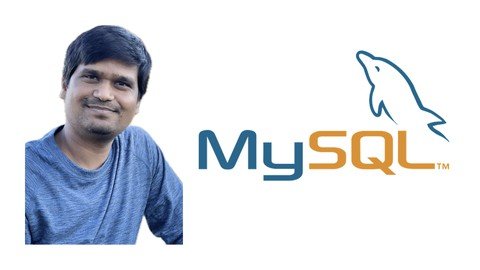

E-Books / Video Training →Master On Mysql Database In–Depth Exploration
Published by: voska89 on 15-03-2024, 05:46 |  0
0

Free Download Master On Mysql Database In–Depth Exploration
Published 2/2024
MP4 | Video: h264, 1920x1080 | Audio: AAC, 44.1 KHz
Language: English | Size: 858.54 MB | Duration: 2h 23m
Understanding about MySQL database from basics to expert level.
What you'll learn
Understanding databases and their role in applications.
Retrieving data using SELECT statements.
Advanced Queries - Working with joins to combine data from multiple tables.
Database Design - Normalization and denormalization
Transactions and Concurrency - ACID properties (Atomicity, Consistency, Isolation, Durability)
Stored Procedures and Functions
Security and Optimization
Advanced Topics - Triggers and events for automation
Real-world Applications - Building and designing databases for specific applications
Best Practices and Troubleshooting
Requirements
Familiarity with using computers and navigating different operating systems.
Basic understanding of what databases are and their purpose in software development.
Some familiarity with SQL (Structured Query Language) basics would be beneficial but not mandatory.
Access to MySQL software for installation and practice. MySQL is freely available and downloadable, so access should not be a major hurdle.
A keen interest in databases and a willingness to dive into complex topics and problem-solving.
Description
Mastering MySQL database involves a comprehensive understanding of its architecture, features, and various aspects of database management. Here's an in-depth exploration to help you on your journey:1. Understanding MySQL Basics:Database Concepts: grasp fundamental concepts like tables, rows, columns, indexes, and relationships.Data Types: familiarize yourself with different data types MySQL supports.2. Installation and Configuration:Installation: learn how to install MySQL on different operating systems.Configuration: understand and configure key parameters in my.cnf for optimal performance.3. SQL Fundamentals:Querying: master SELECT statements, filtering, sorting, and joining tables.Data Manipulation Language (DML): INSERT, UPDATE, DELETE operations.Data Definition Language (DDL): CREATE, ALTER, DROP statements.4. Indexes and Optimization:Indexes: comprehend index types (B-Tree, FULLTEXT, etc.) and their impact on performance.Query Optimization: use EXPLAIN to analyze and optimize queries.5. Normalization and Database Design:Normalization: understand normalization forms to design efficient database schemas.ER Modeling: grasp Entity-Relationship modeling for effective database design.6. Transactions and Concurrency:ACID Properties: understand and implement Atomicity, Consistency, Isolation, and Durability.Concurrency Control: manage simultaneous transactions using locking mechanisms.7. Security:User Management: create and manage user accounts with appropriate privileges.Authentication and Authorization: configure secure authentication methods and define access controls.8. Backup and Recovery:Backup Strategies: implement regular backups using tools like mysqldump.Point-in-Time Recovery: learn how to recover databases to a specific point in time.9. High Availability and Replication:Replication: set up and manage master-slave replication for redundancy and scalability.Load Balancing: implement load balancing for distributing database traffic.10. Monitoring and Performance Tuning:MySQL Performance Schema: use performance schema for monitoring and troubleshooting.Query Cache and Buffer Pool: tune key parameters for optimal performance.11. Advanced Topics:Stored Procedures and Functions: create and use stored procedures and functions.Triggers: understand and implement triggers for automated actions.Partitioning: optimize large tables by partitioning data.12. Community and Documentation:MySQL Community: engage with the MySQL community for support and knowledge sharing.Official Documentation: refer to the MySQL official documentation for in-depth information.13. MySQL Tools:Command-Line Tools: become proficient in using tools like mysql, mysqldump, etc.GUI Tools: explore GUI tools like MySQL Workbench for visual database management.14. Scalability:Sharding: understand and implement sharding for horizontal scalability.Caching Strategies: implement caching mechanisms for improved performance.15. Continuous Learning:Stay Updated: MySQL evolves, so keep abreast of the latest features and best practices.Online Courses and Certifications: consider taking advanced courses and certifications to validate your skills.Conclusion:Mastering MySQL requires a combination of theoretical knowledge and hands-on experience. Practice with real-world scenarios and projects, participate in the MySQL community, and continually update your skills to stay at the forefront of database management.
Overview
Section 1: Introduction
Lecture 1 Introduction
Lecture 2 About the Instructor
Lecture 3 Prerequisites
Lecture 4 About Databases
Lecture 5 About MYSQL
Lecture 6 Course Material
Section 2: Fundamentals of MySQL
Lecture 7 Installing and setting up MySQL.
Lecture 8 Connecting to database - Command line & MYSQL Workbench
Lecture 9 Understanding databases and their role in applications.
Lecture 10 Basics of SQL (Structured Query Language).
Lecture 11 Data Load for into Database for Course
Lecture 12 Creating, altering, and dropping databases
Section 3: Data Manipulation
Lecture 13 Retrieving data using SELECT statements.
Lecture 14 Filtering and sorting data with WHERE clause.
Lecture 15 Filtering and sorting data with ORDER BY clauses.
Lecture 16 Filtering and sorting data with DISTINCT and LIMIT clauses.
Lecture 17 Summary of SELECT Statements
Lecture 18 Modifying data - INSERT Operations
Lecture 19 Insert Operations - INSERT IGNORE & INSERT ON DUPLICATE KEY UPDATE
Lecture 20 Summary of Insert Operations
Lecture 21 Update Query Operations
Lecture 22 Delete Query Operations
Lecture 23 Update & Delete Operations Summary
Lecture 24 Aliases
Section 4: MYSQL Joins
Lecture 25 Introduction to MySQL join clauses
Lecture 26 INNER JOIN - Hands on
Lecture 27 LEFT JOIN - Hands on
Lecture 28 RIGHT JOIN - Hands on
Lecture 29 FULL JOIN - Hands on
Lecture 30 CROSS JOIN - Hands on
Lecture 31 SELF JOIN
Lecture 32 Summary
Section 5: Congratulations - Master on MYSQL Database
Lecture 33 Course Summary
Lecture 34 BIG THANK YOU
Individuals with little to no prior experience in databases or SQL who want to build a strong foundation in MySQL from scratch.,Those who have some familiarity with databases or SQL but want to deepen their understanding and proficiency in MySQL.,Software developers or programmers seeking to expand their skills by learning database management and SQL in the context of MySQL.,Professionals already working or aspiring to work in database administration who want to enhance their knowledge and expertise in MySQL.,Those pursuing degrees or careers in information technology, computer science, software engineering, or related fields, aiming to gain a strong understanding of databases.,Individuals interested in data management, data analysis, or working with databases for personal or professional projects.
Homepage
https://www.udemy.com/course/master-on-mysql-database-in-depth-exploration/Buy Premium From My Links To Get Resumable Support,Max Speed & Support Me
Rapidgator
blskg.Master.On.Mysql.Database.InDepth.Exploration.rar.html
Uploadgig
blskg.Master.On.Mysql.Database.InDepth.Exploration.rar
NitroFlare
blskg.Master.On.Mysql.Database.InDepth.Exploration.rar
Fikper
blskg.Master.On.Mysql.Database.InDepth.Exploration.rar.html
No Password - Links are Interchangeable
Related News
-
{related-news}

